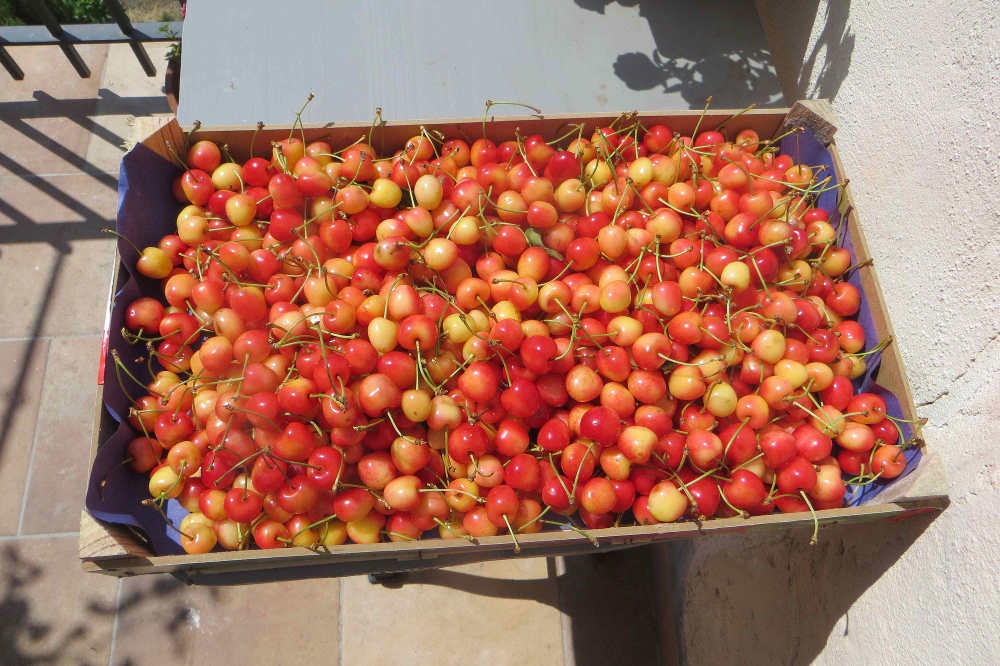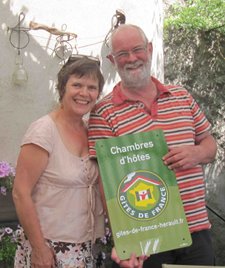An Irish Chef in France

Euro-Toques chef Martin Dwyer, is much missed in Ireland since he and his wife Sile sold their eponymous restaurant in Waterford and moved to France. They now live in the Languedoc, where they take guests - and feed them very well.
This month: White Cherry Jam
It must have been in 2007, shortly after we bought the house, when we were exploring about the lovely villages in the Haut Languedoc that we saw a man who had set up a stall outside his farm gate and seemed to be selling cherries.
It would have been around the beginning of June when most of the cherry harvest is over in this part of the world. These, we immediately noticed were not the usual red cherries but were yellow with pink stripes.
Monsieur invited us to sample one and they were really good, not the usual balls of sugar and juice but had rather more flavour and were not as sweet as the red ones. When asked how much they were M. said they were €2.50 a kilo, but if we liked we could have the whole box (about three kilos) for €5.
We took the box and M. retired indoors, delighted, his selling day over.
If you run a Chambre d’Hote in France you soon realise that the French vision of breakfast is Coffee, with fresh baguette and lots of jam. Jam was no sooner made in our kitchen but it was consumed by the jarful by our clients.
We decided to turn the three kilos of cherries into jam. It made a delicious end product, the extra acidity giving the jam more flavour than the red variety. A little bit of research on the internet revealed that our cherry was called a Cerise Napoleon- no doubt because it had been great favourite with the Emperor.
The following year we went searching again for the Napoleons but this time we couldn’t find any. Despite crawling along the roads where we thought we had found them being sold we never succeeded in finding Monsieur at his gate.
I made a few enquiries at the local markets but it seemed that nobody grew these old fashioned cherries any more. The market seemed to be for the red variety which, though delicious when they arrived first in May, were just not as good for jam.
Then just two years ago we were driving through Tarrassac where a high suspension bridge crosses the Orb when, in the old village on the side of the bridge we found a lady, outside the door of an old long defunct Boucherie, selling cherries. On closer inspection it turned out that she had the elusive Napoleons, about two kilos, needless to say we bought the lot.
Last year we missed them, the season was over when we went looking so this year I was determined this wouldn’t happen. Passing through Tarrassac about three weeks ago we saw Madame at her door selling her red cherries. I asked her about her yellow ones. She firstly corrected us, they were not yellow but white - she explained - “That’s right” I said “Napoleons”. She was impressed. Then she explained that the white were a later fruiting variety and wouldn’t be ready for a few weeks yet.
I told Madame that I had a Chambre d’Hote and had found that her cherries made delicious jam, if I gave her my card would she promise to call me when they were ready. She duly promised.
Last Thursday Madame called and said the cherries were ripe; I asked her to put aside four kilos for me and promised to collect them the following day. This is why yesterday found me travelling up the side of the Orb River along the corniche of Le Vallee d’Orb on my way to collect the cherries.
The village of Tarrassac is only about 34 km from our village but as the road twists and winds over the Garrigue and along the side of the river it takes about three quarters of an hour to get there.
Once you pass through Murviel the road climbs up to the Garrigue at Causses et Veyran, wonderful moorland landscape with only the odd vineyard flourishing on the thin soil. Once you get to Roquebrun the vegetation changes and you are firmly back in wine country. Because this village is totally protected from the north it is called Le Petit Nice and wonderful lemon and orange trees, full of fruit in February and at the same time amazing displays of Mimosa.
Roquebrun is part of the St. Chinian appellation and (in my opinion) they produce the finest wine of that region. The vineyards here are on the side of the south facing hills where no mechanical grape picker can venture and so they are all picked by hand. The wine from the co-op in the village is our house wine in Le Presbytere.
At Tarrassac I knocked on the door of the Ancienne Boucherie and a very old Granny gave me my large box of cherries and charged me ten euro for the fruit.
This morning I had the task of stoning these beauties. A couple of years ago I found an old cherry stoner in a Vide Grenier, a simple device a bit like an old fashioned garlic squeezer. This machine is not always easily used with the modern larger juicy cherries but is perfect for these smaller, old fashioned varieties.
At 8.30 this morning I set myself up on our sunny terrace, still reasonably cool until the sun comes around to heat it later, and armed with my trusty machine set about the task.
I must confess at this moment that if one is going to face a long repetitive task it is considerably easier to perform it on a south facing terrace in southern France where the birds alone offer entertainment.
Our resident Hoopoe has returned again this year and his gentle hooting call is very soothing, as are the calls of the dove population who seem to be intent on wooing each other. The Swifts and Martins are certainly not as soothing as they dive bomb the terrace, screaming as they go. It is however consoling that in their bombing raids they are swallowing flies and mosquitoes.
It took me an hour and a half to stone the cherries, and another ten minutes to clean up the copious amounts of cherry juice from the terrace.
It seems that actually making the jam is going to be the easiest part of this operation.
-------------
 Martin Dwyer started cooking professionally over 40 years ago in the legendary “Snaffles Restaurant” in Dublin. After a time in a Relais Chateau in Anjou and in “The Wife of Bath” in Kent he opened his own much acclaimed restaurant, “Dwyers”, in Waterford in 1989. In 2004 he sold this and moved south to France where he and his wife Síle bought and restored an old presbytery in a village in the Languedoc. They now run Le Presbytère as a French style Chambre d’Hôte. Martin however is far too passionate about food to give up cooking so they now enjoy serving dinner to their customers on the terrace of Le Presbytère on warm summer evenings. Martin runs occasional cookery courses in Le Presbytère and Síle’s brother Colm does week long Nature Strolls discovering the Flora and Fauna of the Languedoc.
Martin Dwyer started cooking professionally over 40 years ago in the legendary “Snaffles Restaurant” in Dublin. After a time in a Relais Chateau in Anjou and in “The Wife of Bath” in Kent he opened his own much acclaimed restaurant, “Dwyers”, in Waterford in 1989. In 2004 he sold this and moved south to France where he and his wife Síle bought and restored an old presbytery in a village in the Languedoc. They now run Le Presbytère as a French style Chambre d’Hôte. Martin however is far too passionate about food to give up cooking so they now enjoy serving dinner to their customers on the terrace of Le Presbytère on warm summer evenings. Martin runs occasional cookery courses in Le Presbytère and Síle’s brother Colm does week long Nature Strolls discovering the Flora and Fauna of the Languedoc.
Le Presbytère can be seen at: www.lepresbytere.net;
email: martin@lepresbytere.net
Twitter: www.twitter.com/DwyerThezan





There are currently no comments
Leave a comment
Not a member? Register for your free membership now!
Or leave a comment by logging in with: